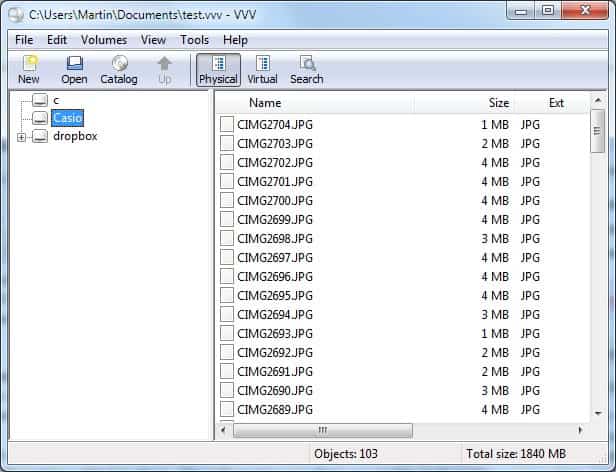Disk Catalog Software Virtual Volumes View

Virtual Volumes View (VVV) is a free disk catalog software for Linux, Apple Macintosh and Microsoft Windows machines. Designed first and foremost for cataloging CD and DVD discs, it may also be used to arrange files and folders as virtual volumes to catalog them as well.
The program provides you with options to search all cataloged volumes created previously, making it ideal for off-line searching and archiving projects.
For instance, it may be used to catalog data discs, backups or file collections, so that users can search across them all using the program.
Virtual Volumes View is relatively easy to use. It works by creating catalog files that are then filled with file and folder information from the local computer system. It is possible to point the disk cataloging software to a folder on the hard drive, or media such as CDs or DVDs.
So, if you have hundreds or thousands of backup or data discs lying around, you may use the program to catalog them all. Then, you may use it at any time to find specific files quickly.
Virtual Volumes View
Once you select a location that you want to catalog, all files and folders of that structure are scanned and added to the index.
Virtual folders contain physical file information, and the information contained are accessible when accessing the physical or virtual folder.
Basically, what it enables you to do is search catalogs that you created previously regardless of whether files or folders are accessibly physically.
Virtual Volumes View supports search functionality to find specific files quickly. You may run searches for names, partial names, extensions, or even descriptions added during the cataloging process.
It is furthermore possible to update existing volumes. This is a handy feature in case the content changes. While this won't happen for optical discs that are not rewritable, it may be the case for locations on the computer that were cataloged before.
Virtual Volumes View can be used over a computer network. This requires the installation of a database server.
The process is explained in the help file and on the program's homepage. VVV can be downloaded for all supported operating systems from the Sourceforge project page.
Closing Words
Virtual Volumes View is an easy to use cataloging program for various operating systems. Designed to catalog discs, it supports other data types as well making it universally useful for archiving purposes.



























I think it is most stupid that the program does not show the size of directories – that is something so obviously missing, that I wonder if the author even uses this software himself.
Cathy is much faster and more usable in real life.
I use EF File Catalog to catalog my files stored on my backup drives, CDs, DVDs. It lets me search the content of archives and detect duplicate items. It can be stored on Flash disks or other portable devices.
http://bstdownload.com/reviews/ef-file-catalog-portable-2/
Where is the download link for the program
Looks promising but the update feature .. I dont get it : I believe you catalog a location so it can be updated later but the physical location is NOT memorized so it ask for the location again when updating, it is nonsense or I missed something? I though clicking update (or better global update) would be enough but … nope … anything I missed?
The program asks for the location again when you update a volume because the program is designed to handle REMOVABLE volumes.
Being removable, the volumes might be located in a different path.
Think of a DVD disk. You may move the catalog to another computer, you might even update it from another computer connected to the same network.
You might even update it from a Linux computer while you cataloged it for the first time from a Windows computer.
For these reasons you cannot be sure that the same volume will get again the same path, so the program asks for it again.
BTW, there is no point in writing questions in a sourceforge review, where there is no way to give an answer.
Right on!